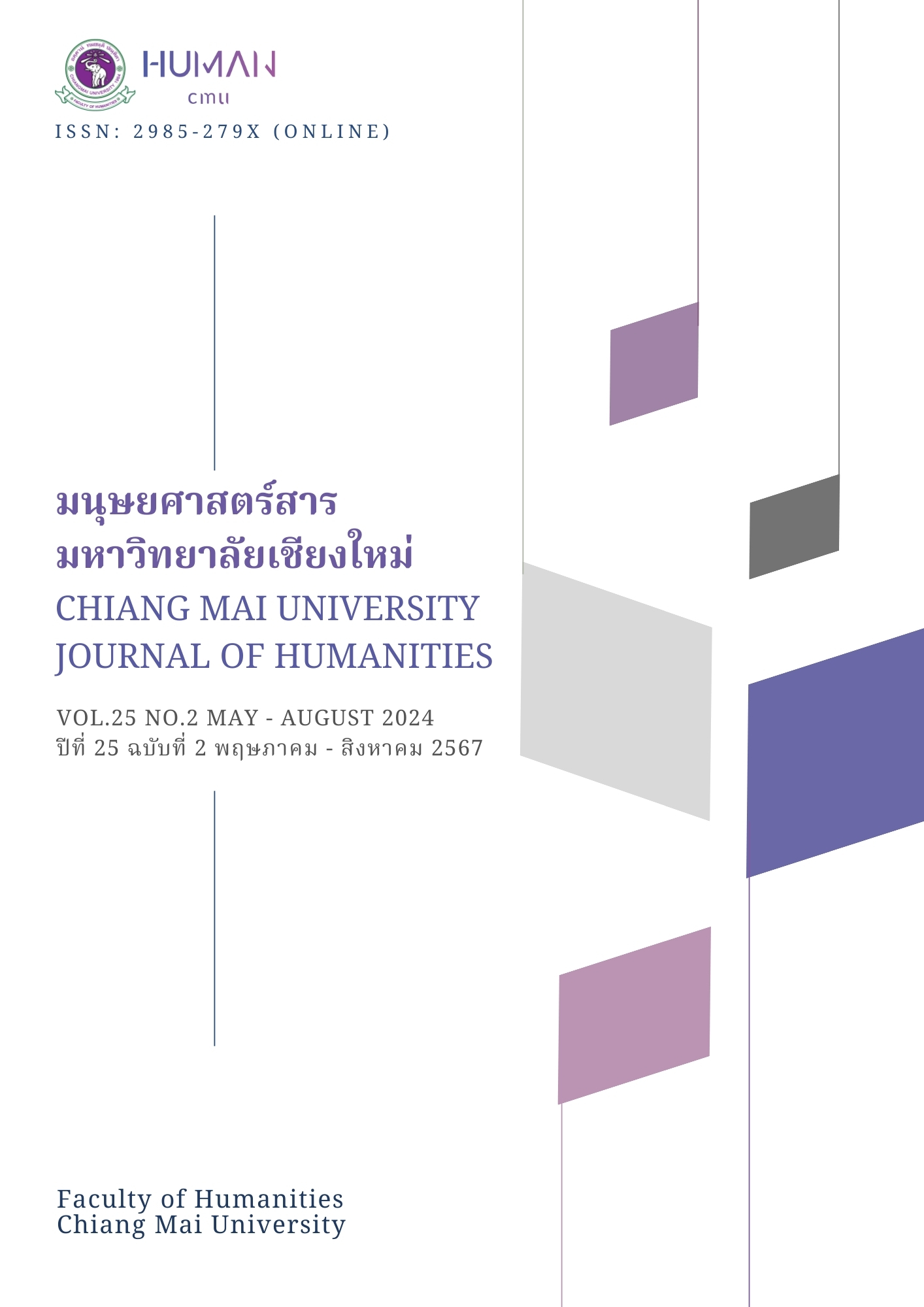มุมมองต่อตนเองและประสบการณ์การมีรอยสักในกลุ่มคนไทยวัยผู้ใหญ่ตอนต้น
Main Article Content
บทคัดย่อ
งานวิจัยนี้มีวัตถุประสงค์เพื่อศึกษาและทำความเข้าใจคุณค่าและความหมายของการมีรอยสักต่อการรับรู้ตัวตนของบุคคล ในกลุ่มผู้ให้ข้อมูลชาวไทยวัยผู้ใหญ่ตอนต้น งานวิจัยนี้ศึกษาด้วยการวิจัยเชิงคุณภาพด้วยการวิเคราะห์เชิงปรากฎการณ์วิทยาแบบตีความ เก็บข้อมูลด้วยการสัมภาษณ์เชิงลึก จากผู้ให้ข้อมูลจำนวน 7 คน (เป็นเพศหญิงจำนวน 4 คน) ที่มีอายุระหว่าง 21-29 ปี และมีรอยสักถาวรบนร่างกายมากกว่า 1 แห่ง ผลการวิเคราะห์ข้อมูล พบว่าการมีรอยสักส่งเสริมให้บุคคลเกิดความเจริญงอกงามในหลากหลายแง่มุม ทั้งความมั่นใจในรูปลักษณ์ภายนอกที่เพิ่มขึ้น ความกล้าที่จะทำสิ่งใหม่ที่ไม่เคยทำ ความรู้สึกถึงอิสระในการเป็นตัวเองชัดเจนขึ้น และการพัฒนาตนเองจากความผิดพลาดในอดีต ประเด็นที่สอง พบความกังวลต่อสายตาของผู้อื่นจากการที่ตนมีรอยสัก ทั้งในบริบทของครอบครัว และบริบทของที่ทำงานที่ยังมีการตัดสินคุณค่าของผู้มีรอยสักในแง่ลบ และประเด็นสุดท้าย กล่าวถึงเสียงสะท้อนจากผู้มีรอยสักต่อคนในสังคม เมื่อการมีรอยสักนั้นมีความหมายต่อตัวตนเจ้าของรอยสัก จึงขอให้สังคมยอมรับในวุฒิภาวะที่จะตัดสินใจเกี่ยวกับร่างกายของตน ผลที่ได้จากการวิจัยนี้สะท้อนออกมาถึงคุณค่าและความหมายรอยสักจากมุมมองของผู้ที่มีรอยสักได้อย่างชัดเจน ขณะเดียวกันยังชี้ให้เห็นถึงภาพการตีตราของสังคมผ่านการรับรู้ของผู้มีรอยสักอีกด้วย
Article Details

อนุญาตภายใต้เงื่อนไข Creative Commons Attribution-NonCommercial-NoDerivatives 4.0 International License.
เอกสารอ้างอิง
ชมพูนุท ศรีจันทร์นิล. (2560, มกราคม). การวิเคราะห์เชิงปรากฏการณ์วิทยาแบบตีความ: ระเบียบวิธีวิจัยเชิงคุณภาพสําหรับการวิจัยทางด้านจิตวิทยา. วารสารศึกษาศาสตร์ มหาวิทยาลัยบูรพา, 28 (3), 1-13. https://ojs.lib.buu.ac.th/index.php/education2/article/view/5611
นราทร คงดนตรี, นราธิป สิทธิพรรัตนมณี, ณัฐพล ลาภวรชัย, ปวเรศ ชูไพร, พชร นุ่มดี, และ พิทักษ์ ศิริวงศ์. (2564, กุมภาพันธ์). วัฒนธรรมการสัก การให้ความหมาย ประสบการณ์และแรงจูงใจในการสักของนักศึกษา มหาวิทยาลัยศิลปากร วิทยาเขตสารสนเทศเพชรบุรี [Paper presentation]. งานประชุมวิชาการระดับชาติ ครั้งที่ 8 คณะบริหารธุรกิจ มหาวิทยาลัยแม่โจ้, เชียงใหม่, ประเทศไทย.
พัชรี สระบัว. (2564). ทัศนคติที่มีต่อสุภาพสตรีที่มีรอยสักประเภท Minimal Tattoo [สารนิพนธ์ปริญญามหาบัณฑิต, มหาวิทยาลัยมหิดล]. CMMU Digital Archive. https://archive.cm.mahidol.ac.th
/handle /123456789/4133
พูนทรัพย์ โพธิ์พันธุ์. (2549). การศึกษาเรื่องการสักของคนไทยสมัยอยุธยาถึงสมัยรัชกาลที่ 5 (พ.ศ. 1893-2453) [สารนิพนธ์ปริญญามหาบัณฑิต, มหาวิทยาลัยศรีนครินทรวิโรฒ]. http://thesis.swu.ac.th/swuthesis
/His/Phoonsub_P.pdf
ราชบัณฑิตยสถาน. (2554). การสัก. พจนานุกรม ฉบับราชบัณฑิตยสถาน พ.ศ. ๒๔๕๔. https://dictionary.orst.
go.th/
รุ่งนภา นาคสมพันธ์ และ ไชยันต์ สกุลศรีประเสริฐ. (2566). เรื่องเล่าในรอยสัก: เรื่องราวชีวิตและการประกอบสร้างอัตลักษณ์. มนุษยศาสตร์สาร, 24(1), 204-225.
วรวรรณ บุญรัตน์. (2561). “หญิงร้าย” ในประวัติศาสตร์ไทย. สงขลานครินทร์ ฉบับสังคมศาสตร์และมนุษยศาสตร์, 24(3), 239-248.
MCOT digital (9 มีนาคม 2566). ชัดๆไปเลย มีรอยสักแบบลิซ่า รับราชการได้ไหม. https://www.mcot.net/view/wB3IZoFX#:~:text=%E0%B8%AA%E0%B8%B3%E0%B8%AB%E0%B8%A3%E0%B8%B1%E0%B8%9A%E0%B8%9A%E0%B8%B8%E0%B8%84%E0%B8%84%E0%B8%A5%E0%B8%97%E0%B8%B5%E0%B9%88%E0%B8%A1%E0%B8%B5%E0%B8%A3%E0%B8%AD%E0%B8%A2,%E0%B8%AA%E0%B8%B1%E0%B8%81%E0%B9%84%E0%B8%A7%E0%B9%89%E0%B9%81%E0%B8%95%E0%B9%88%E0%B8%AD%E0%B8%A2%E0%B9%88%E0%B8%B2%E0%B8%87%E0%B9%83%E0%B8%94
Thairath ออนไลน์. (6 เมษายน 2561). ฉุกคิดสักนิดก่อนคิดไปสัก! ส่องอาชีพไหนบ้าง รับ-ไม่รับผู้มีรอยสัก. https://www.thairath.co.th/news/society/1169937
Baltzer-Jaray, K., & Rodriguez, T. (2012). Fleshy canvas: the aesthetics of tattoos from feminist and hermeneutical perspectives. In R. Arp (Ed.), Tattoos: Philosophy for Everyone: I Ink Therefore I am (p. 38-50). Wiley-Blackwell
Deter-Wolf, A., Robitaille, B., Krutak, L., & Galliot, S. (2016). The world's oldest tattoos. Journal of Archaeological Science: Reports, 5, 19–24. https://doi.org/10.1016/j.jasrep.2015.11.007
Kertzman, S., Kagan, A., Hegedish, O., Lapidus, R., & Weizman, A. (2019). Do young women with tattoos have lower self-esteem and body image than their peers without tattoos? A non-verbal repertory grid technique approach. PloS one, 14(1). https://doi.org/10.1371/ journal.
pone.0206411
Kierstein, L., & Kjelskau, K. C. (2015). Tattoo as art, the drivers behind the fascination and the decision to become tattooed. In J. Serup, N. Kluger, & W. Bäumler (Ed.), Tattooed Skin and Health (p. 37-40). Kraft Druck
MacFarlane, M. (2019). Tattoos in East Asia: Conforming to Individualism. Sound Ideas. https://
soundideas.pugetsound.edu/summer_research/343/
Merriam-Webster. (n.d.). Tattoo. In Merriam-Webster dictionary. Retrieved September 25, 2022, from https://www.merriam-webster.com/dictionary/tattooMerriam-Webster.
Mun, J. M., Janigo, K. A., & Johnson, K. K. P. (2012). Tattoo and the Self. Clothing and Textiles Research Journal, 30(2), 134–148. https://doi.org/10.1177/0887302X12449200
Park, J. (2016). Signs of social change on the bodies of youth: tattoos in Korea. Visual Communication, 15(1), 71–92. https://doi.org/10.1177/1470357215608552
Reid-de Jong, V. (2022). Unveiling beauty: Insight into being tattooed postmastectomy. Nursing Forum, 57(4), 536-544. https://doi.org/10.1111/nuf.12714
Richman-Abdou, K. (2021, July 1). Irezumi: Explore the ancient techniques and evolution of traditional Japanese tattoos. My Modern Met. Retrieved April 23, 2023, from https://mymo
dernmet.com/japanese-tattoo-history/
Roggenkamp, H., Nicholls, A., & Pierre, J. M. (2017). Tattoos as a window to the psyche: How talking about skin art can inform psychiatric practice. World journal of psychiatry, 7(3), 148–158. https://doi.org/10.5498/wjp.v7.i3.148
Ruggs, E. N., & Hebl, M. R. (2022). Do employees' tattoos leave a mark on customers' reactions to products and organizations?. Journal of Organizational Behavior, 43(6), 965-982. https://doi.
org/10.1002/job.2616
Schlösser, A., Giacomozzi, A. I., Camargo, B. V., Silva, E. Z. P. D., & Xavier, M. (2020). Tattooed and Non-Tattooed Women: Motivation, Social Practices and Risk Behavior. Psico-USF, 25(1), 51–62. https://doi.org/10.1590/1413-82712020250105
Swami V. (2011). Marked for life? A prospective study of tattoos on appearance anxiety and dissatisfaction, perceptions of uniqueness, and self-esteem. Body image, 8(3), 237–244. https://doi.org/10.1016/j.bodyim.2011.04.005
Tiggemann, M., & Hopkins, L. A. (2011). Tattoos and piercings: Bodily expressions of uniqueness? Body Image, 8(3), 245–250. https://doi.org/10.1016/j.bodyim.2011.03.007
Weiler, S. M., Tetzlaff, B.-O., Herzberg, P. Y., & Jacobsen, T. (2021). When personality gets under the skin: Need for uniqueness and body modifications. PLOS ONE, 16(3). https://doi.org
/10.1371/journal.pone.0245158
Yamada, M. (2009). Westernization and cultural resistance in tattooing practices in contemporary Japan. International Journal of Cultural Studies, 12(4), 319–338. https://doi.org/10.1177/
Zidenberg, A. M., Dutrisac, S., & Olver, M. (2022). “No ragrets”: Public perceptions of tattooed mental health professionals. Professional Psychology: Research and Practice, 53(3), 304–312. https://doi.org/10.1037/pro0000441


